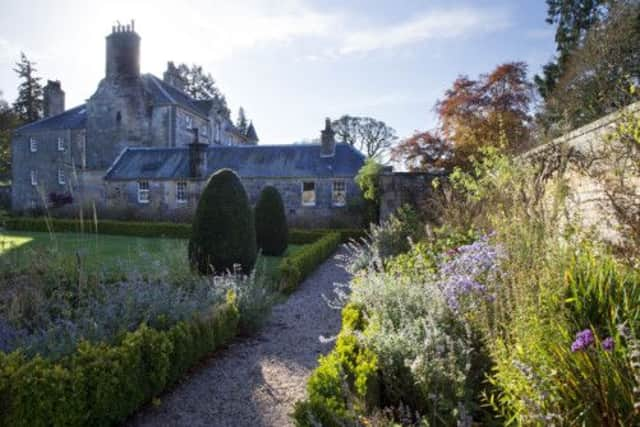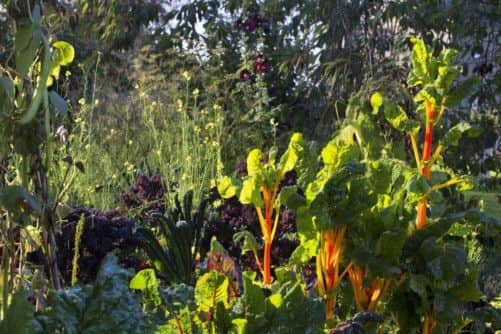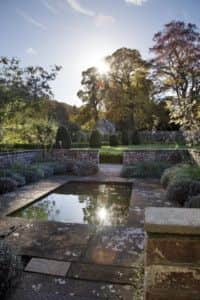Restoring the garden of 15th century Kemback House


KEMBACK, the Fife home of the Thomson family for the past century, sits in an elevated position surrounded by magnificent, tree-studded policies. The result of generations of skilled planting, Kemback is striking at any time of the year but in autumn the estate takes on an extra touch of drama when the ancient beech, oak, chestnut and birch turn gold and scarlet in contrast to established conifers. Autumn colour and planting continues in the walled garden where the fiery rounded acers are as striking as any you would find in Asia.
Dating from the 15th century, Kemback has had only four owners: the Archbishops of St Andrews and the University followed by the Schevez and later the Makgill family. The present incumbents, Christopher and Claire Thomson, took over the property from Christopher’s father in 2000 finding out shortly thereafter that the house was riddled with dry rot. This, Christopher explains, was the catalyst for a major restoration project. “While we were waiting for planning permission to start work on the house we decided to get going on the garden.”
Advertisement
Hide AdAdvertisement
Hide AdThe first step involved cutting back the overgrown laurels and rhododendrons at the front of the house, opening up westerly views over the park and the Lomond Hills. Landscape designer Michael Innes laid out the water features, ponds and waterfalls scattered throughout the park, and was succeeded by Colin McBeath from Fife-based Quercus Land Art, who took responsibility for the on-going planting and maintenance programme.


This included dramatic projects such as the resurrection of a 17th-century Lime tree close to the entrance, the planting of drifts of pale grasses sited to maximise the impression of sun and shade and, as on a recent sunny autumn morning, the massed plantings of bulbs including varieties of narcissi.
In the walled garden there were two important criteria to be considered: the structure of the fruit trees, the central apple walk in particular, and the pears, peach and currant trees that cover almost every inch of the walls and water. Described by Christopher as higgledy-piggledy, this ancient and still-productive medieval walled garden has evolved to include a main area loosely attached to a second satellite area planted with varieties of Scottish apples.
Water was introduced by means of a stone-edged rill, fed by the Kemback Hill, laid out along the north side of the house. “We wanted to bring the sound of water into the garden,” Christopher says. At the same time, Michael Innes planted the box hedges that frame the layout of paths and designed an initial planting scheme.
Later, with Colin’s help, the herbaceous planting took on a new and exciting dimension. Here, Colin explains, the brief was for, “500m sq of sustainable, low-maintenance naturalistic planting for year-round interest incorporating a range of rare musk and damask roses.” With detailed research involved in finding exactly the right plant for the right place, Colin points out that his schemes require no more than 15 minutes maintenance per year. This work, as well as the on-going immaculate daily maintenance of the park, is undertaken by head gardener Brian McDill with minimal extra help.


Key plants that stand out among the acers in early November include grasses such as Calamagrostis x acutiflora ‘Karl Foerster’ and Deschampsia cespitosa ‘Goldtau’. The tall cardoon, Cynara cardunculus, still displays its silver leaves while different varieties of red flowering Persicaria had avoided the frost and were still flowering. “Once they are hit by the frost they will collapse, so tuck them at the back of the border,” Colin advises, adding that only the sappy plants will be cut back, the rest will be allowed to stand. Purple asters combine with tall, yellow Rudbeckia and the spikey iris foliage are a reminder that this garden takes you through the seasons.
Shortly thereafter the couple’s daughter, Heloise, suggested the introduction of a potager. The sloping ground at the top east of the garden was earmarked and after much consultation with Colin this became the Ornamental Potager Garden: everything has to be edible, including ornamental plants. Even for Colin, with 30 years’ experience in horticulture, the research produced some interesting results, especially among the perennials with Centranthus rubra ‘Alba’ – the roots can be boiled in soup – Ground Ivy, Vietnamese Fish mint and the Fiddlehead fern being some of the more unusual ones.
Separated from the perennials by a sunken circle of simple Everedge the annuals include cornflowers, different beans, Cavalo Nero, beetroot, radishes, varieties of lettuce with the rosy red oak leaf reinforcing the ‘maroon’ theme emphasised by the vertical spires of maroon hollyhocks, whose leaves and flowers are edible, and are a charming addition to any salad.
Advertisement
Hide AdAdvertisement
Hide AdThis project soon inspired the idea of a Gourmet Fruit Garden to reinforce the existing fruit trees. Research into what would benefit from the free-draining Fife soil with its long winters and relatively short growing seasons, produced cranberries, blueberries, mulberry, medlar as well as the more unusual Hazel impregnated with black truffle, and Russian olives.


This adventurous theme continues in the minimally heated greenhouses, once reserved for growing carnations, where among the vines and the tomatoes you will find delicacies such as ginger, cape gooseberries and dwarf pomegranates, which benefit from the warmth of the south-facing wall. The greenhouses also act as a backdrop for the tranquil Japanese Garden, with its pair of acers.
Explore beyond the walled garden and you will find hidden courtyards filled with surprises such as beehives, and maroon and golden maples. These are just a few more examples of the skill, care and attention to detail with which this garden has been brought into the 21st century. And yet, you can’t help feeling that if the earlier owners came back they would be delighted with the results, and would feel quite at home.
• Kemback House, Kemback, Cupar KY15 5TN is occasionally open under Scotland’s Gardens although not in 2014 (www.quercuslandart.com)